There are a wide variety of telescope designs and types that you can go out and purchase.
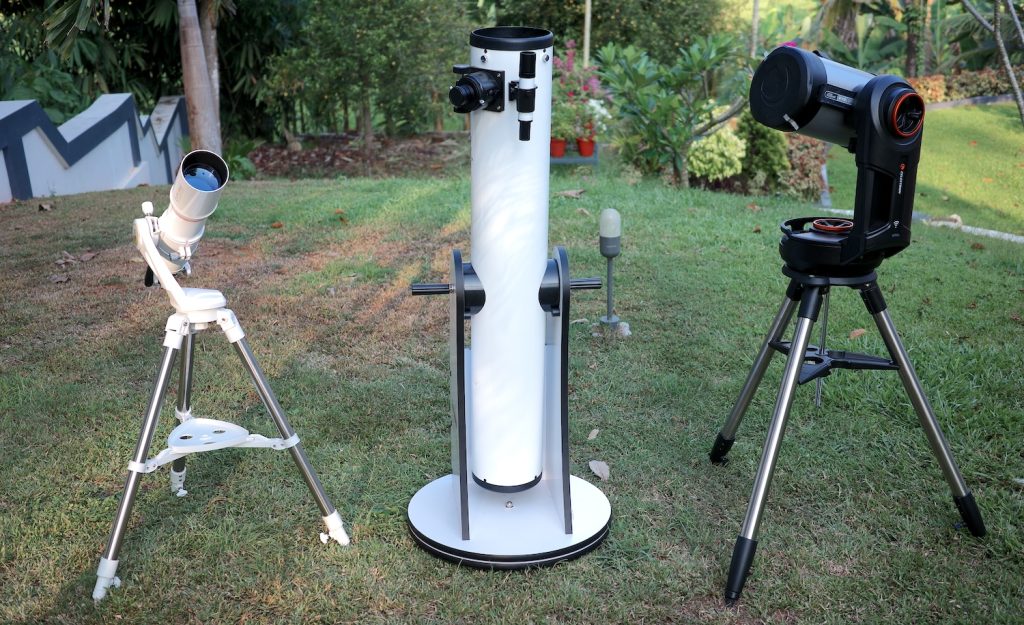
I know that most people are drawn to the elegance and simplicity of a refractor or the stubby but still familiar-looking catadioptric telescopes atop spindly equatorial (EQ) or fork mounts. However, if you’re aiming to get close-up views of star clusters, galaxies, and our Solar System, I believe that the right telescope for you would be an unassuming Dobsonian. But I need to warn you that to many people, Dobsonian would resemble a cannon more than an astronomical instrument and probably isn’t the first thing that comes to their mind when they think of telescopes.
If you’re interested, we have a Dobsonian buyers’ guide that has all the product recommendations.
The Dobsonian telescope is a Newtonian reflector atop a simple altitude-azimuth (alt-az) mount that pivots up and down and left-to-right.
Usually when we talk about telescopes, we refer to the optical tube and mount separately. But in a Dobsonian, the two are inseparable. A Dobsonian telescope is pretty much always a Newtonian reflector combined with a simple dobsonian alt-az mount.
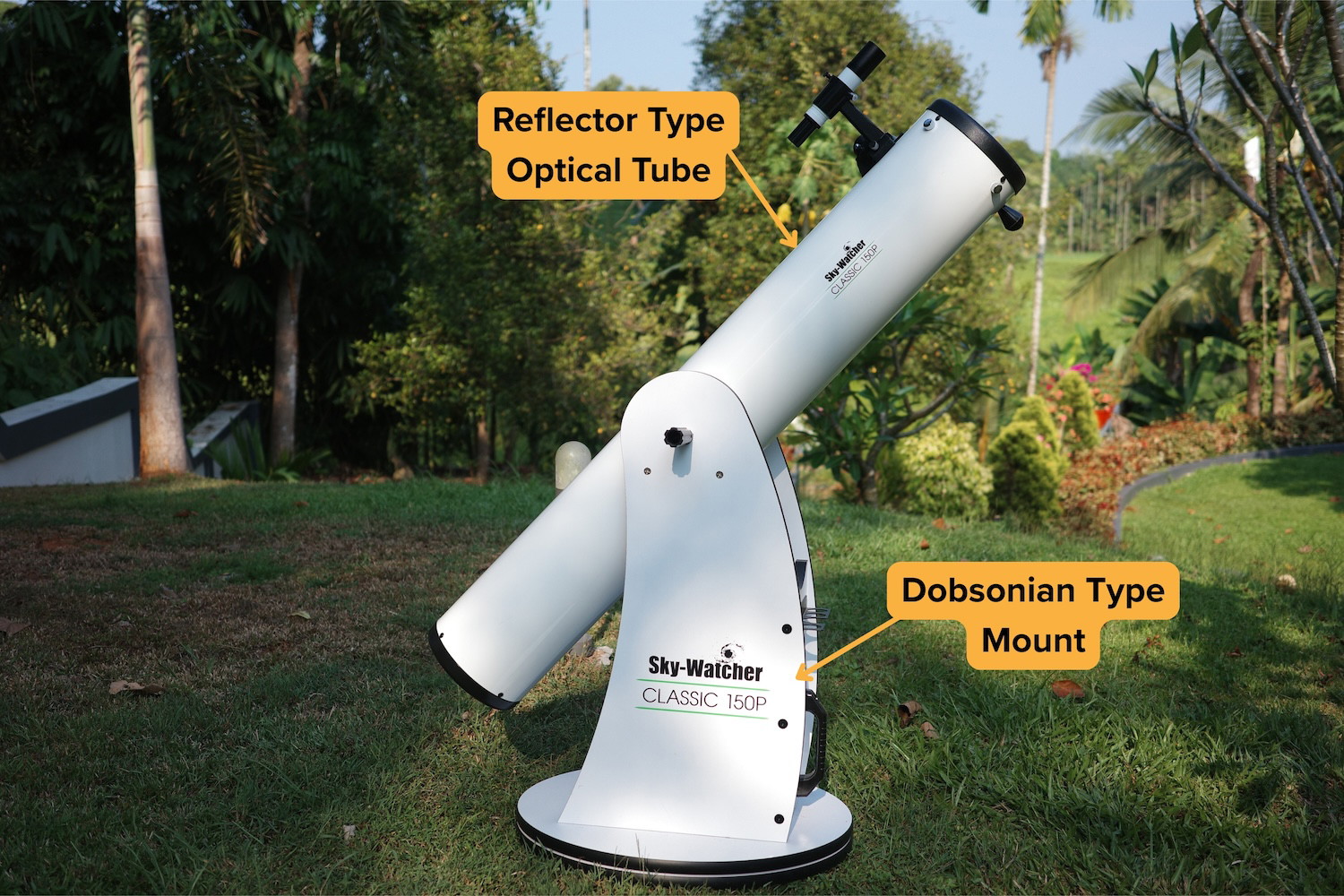
Dobsonian telescopes were designed with the idea of putting more aperture, that is, a larger diameter main mirror to collect more light from distant objects, into the hands of amateurs as cheaply and easily as possible. They do this by using an extremely simple mounting made out of common materials (wood and plastic), which uses few precision parts, combined with the simplest optical configuration (reflector design) available for a good telescope.
This means that the body of the telescope can be easily fabricated with basic hand or power tools at home, while the primary mirror can be ground on your kitchen table. I’ve done both, believe me. Of course, the simplicity here extends to mass-manufactured instruments, which are able to be made out of laser- or CNC-cut wooden parts and cast metal fittings.
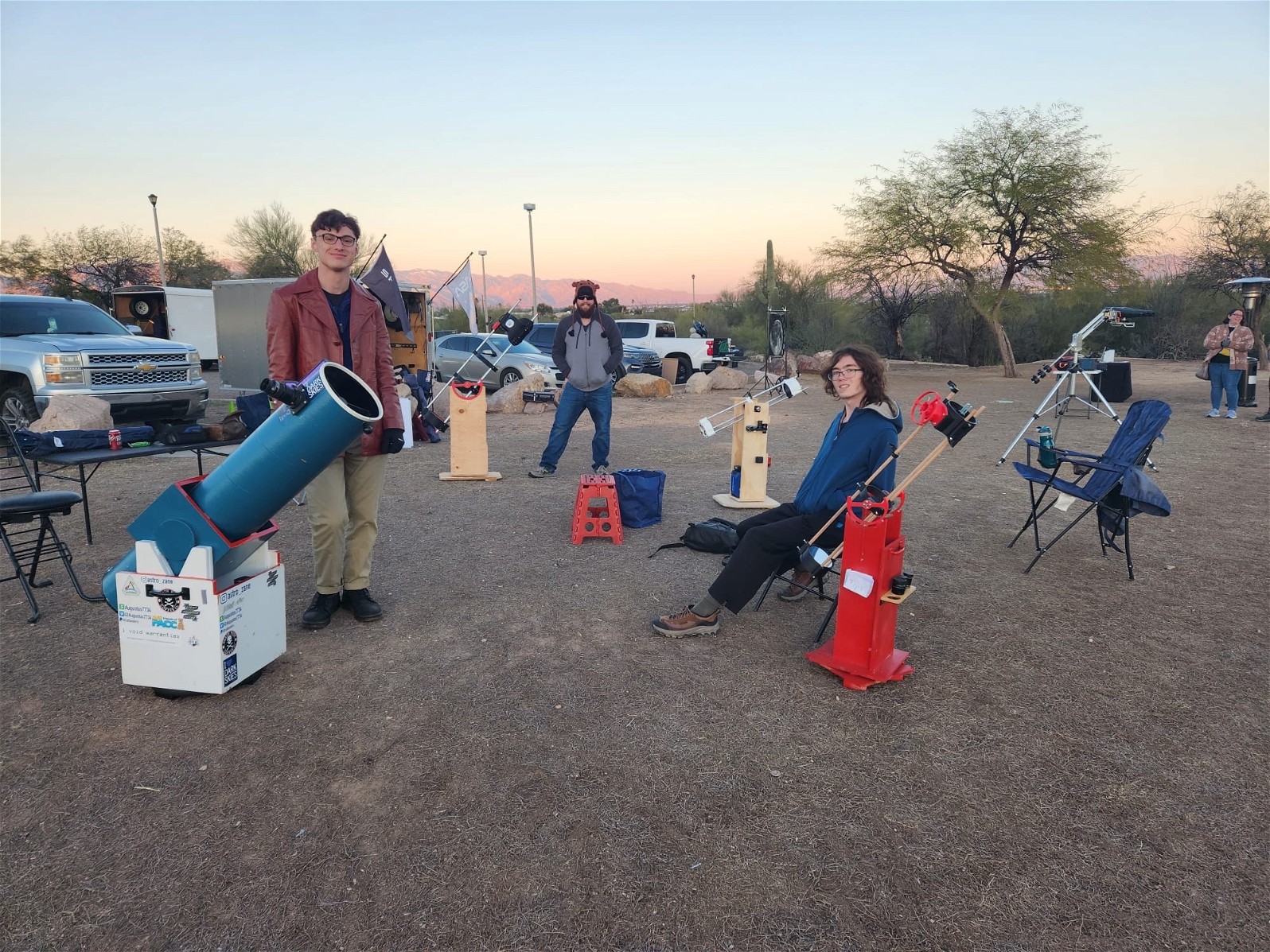
Even a poorly designed commercial Dobsonian is vastly sturdier and of better quality than most undermounted, low-quality “hobby killer” telescopes on tripods that are sold in large numbers to beginners in both online and offline shops alike.
From a telescope’s cost perspective, the Dobsonian tends to be more economical than any other telescope configuration available to amateur astronomers. The only way you are realistically ever going to possess an instrument larger than 12” or so is if it is a Dobsonian (preferably a truss tube). It’s easy to see why when you look at the massive mountings required by most other telescope designs.
Dobsonians are also the easiest telescopes to computerize due to their perfectly balanced nature. Dobsonians utilize the laws of physics alone to balance. They require no clutches, lubricants, or, ideally, any counterweights to move smoothly around the sky.
Lastly, Dobsonians tend to be the most portable telescope design and thus occupy many listings in our portable telescope product guide.
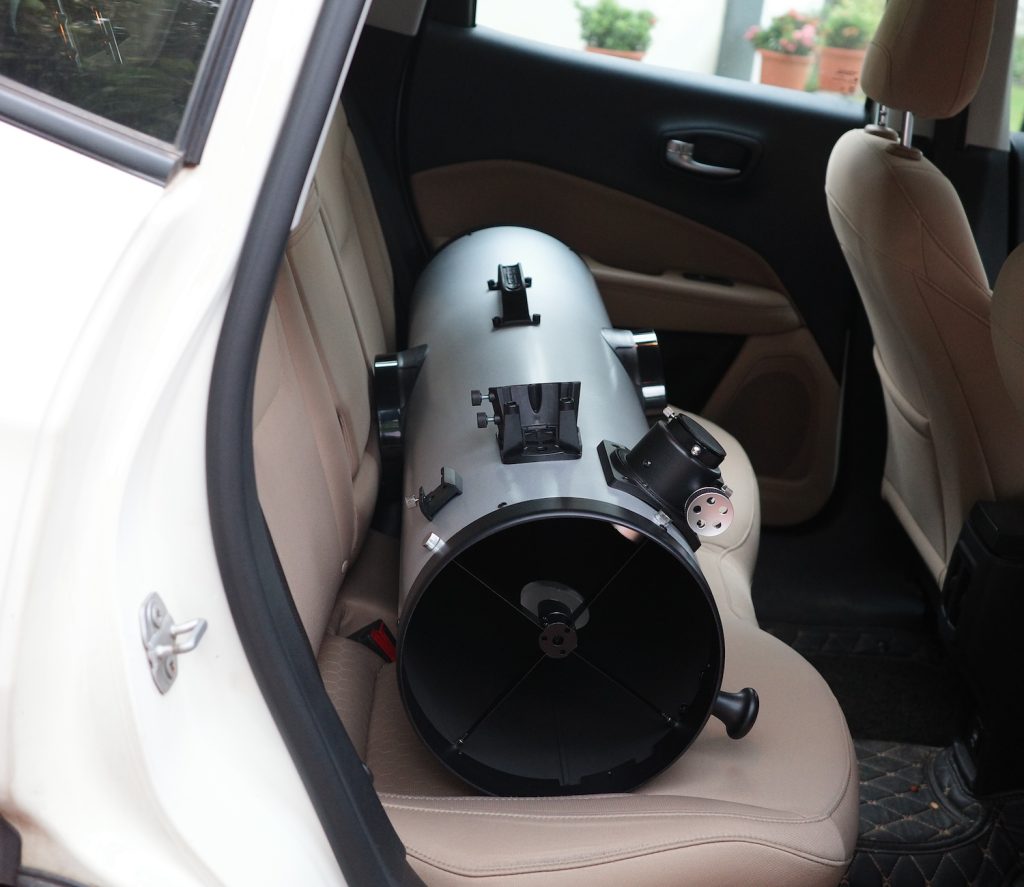
A 10” or smaller in aperture Dobsonian fits in a passenger seat or even a large suitcase, while compact car owners can still accommodate a 16” or even 20” collapsible or truss tube instrument without help setting it up or worrying about a lack of space. This is important since the best quality views through any telescope are often out in the countryside, i.e., far away from city lights.
- Optical Performance: Why Newtonian/Dobsonians Are the Best
- Why Dobsonian Mount Is Best-in-Class
- Cost-Effectiveness of Dobsonians
- Portability of Dobsonian Telescopes
- Ease of Construction
- Longevity
Optical Performance: Why Newtonian/Dobsonians Are the Best
Fundamentally, Dobsonians offer better performance at the eyepiece compared to other telescope designs because they can be built larger than most other optical designs without suffering from an extremely high cost, a narrow field of view, or portability issues.
Newtonian reflectors are fundamentally the only way to obtain a telescope over 16” in aperture, and in the case of most people, a Newtonian/Dobsonian is the only affordable way to get even a 10” telescope.
The larger your telescope’s aperture—that is, the primary objective lens or mirror—the more you can see. A larger mirror has more resolving power and collects more light from distant, faint celestial objects than a smaller one. Area scales with diameter, so a 12” telescope has 4x the light-gathering power of a 6” and twice the resolution.
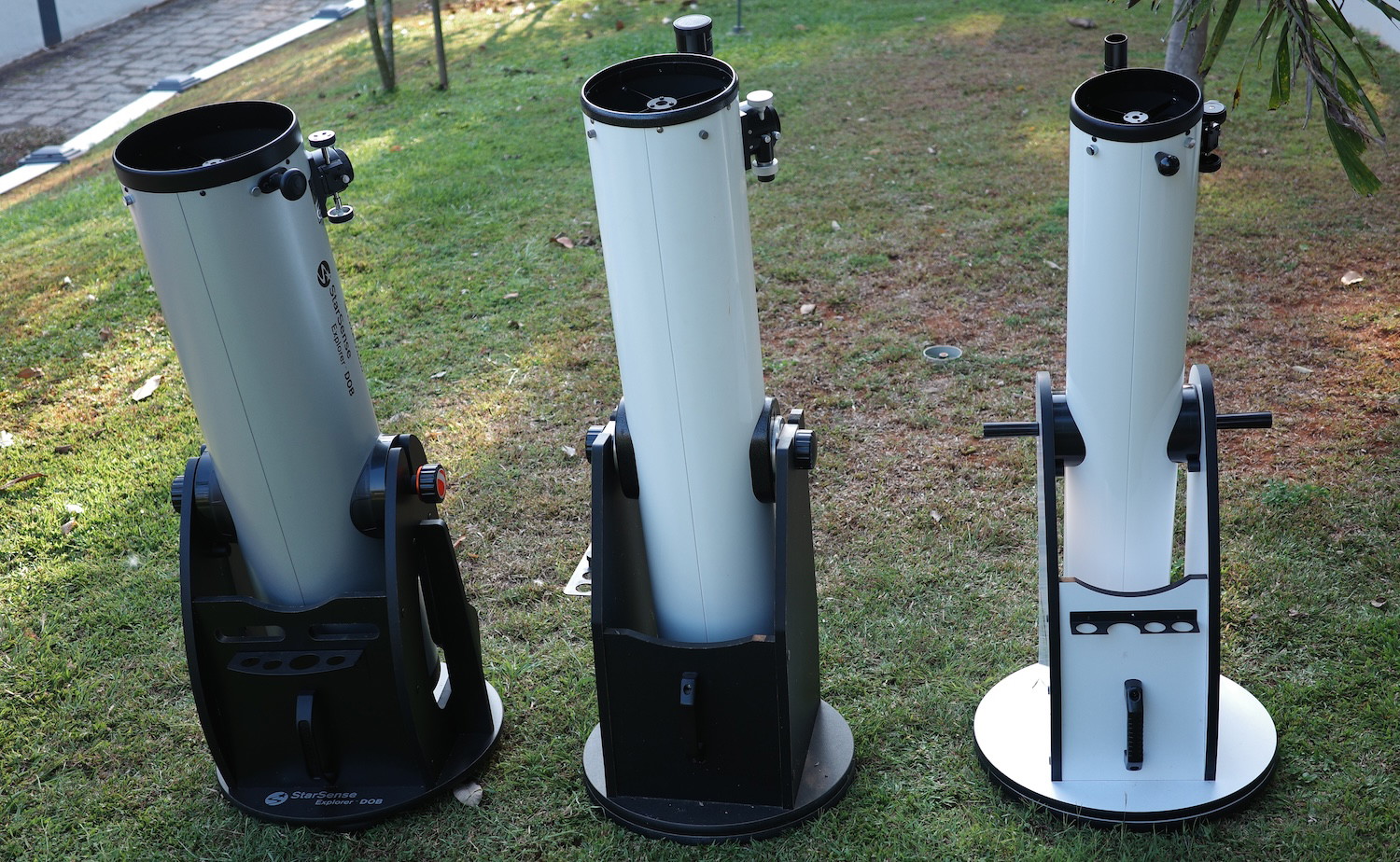
Generally, if possible, I recommend starting with a 6–10″ or maybe 12” telescope.
This is problematic when you consider that the only option besides a Dobsonian/Newtonian that fits the budget of most people might be a rather unwieldy computerized Schmidt-Cassegrain. Why? Well, let’s go over the three main competitors to the Newtonian reflector among amateur astronomers.
- Vs. Refractors
Refractors are celebrated for their sharp, contrast-rich views, primarily because they don’t have a central obstruction like many reflectors.

However, as their size increases, their practicality dwindles rapidly. Refractors exceeding 6″ in aperture become unwieldy. Their weight surges, they demand larger mounts, and the cost escalates exponentially due to the precision required in crafting large refractor lenses free of imperfections. The need for a long focal length to avoid optical aberrations of the lens leads to a very long tube and a narrow field of view, making the telescopes harder to aim and limiting what can be observed with them.
Refractors beyond 8″ are virtually nonexistent in the amateur market due to these impracticalities.
- Vs. Maksutov- and Schmidt- Cassegrains
Maksutov-Cassegrain (Mak) and Schmidt-Cassegrain (SCT) telescopes are the other popular optical designs you’re likely to have up for consideration.
Maksutovs are great scopes. But, like refractors, the cost associated with manufacturing the front corrector lens and their limited field of view prevent instruments over 8” or so from being practical and make 6-7” Maks unwieldy.
So what about the Schmidt-Cassegrain? Well, Schmidts get very heavy and expensive past the 11-12” mark, and they also suffer from a narrow field of view at these sizes.
Well, what do we mean by a narrow field of view?
Focal Ratio, Field of View, and Their Impact on Observing
A telescope’s focal length dictates the magnification and field of view with a given eyepiece. If I use a longer focal length eyepiece, I can decrease the magnification that I get with a long focal length telescope, but the physical area of the maximum field of view I can get is limited to 2” across. This 2-inch limit exists due to the physical constraint of the eyepiece barrel size.
Why the 2-inch limit?
This 2-inch limit refers to the largest possible field stop diameter in 2-inch eyepieces, which is about 46mm. The field stop is the physical ring inside an eyepiece that determines the maximum actual field of view.
Maximum True Field of View =Field Stop Diameter x 57.3/Telescope Focal Length
- A typical Newtonian reflector (includes, by extension, a Dobsonian) has a focal ratio somewhere between f/3 and f/8.
For an 8″ (200mm) dobsonian, the typical focal ratio is f/6. So, the focal length = 1200mm (200mm*6).
Maximum True Field of View = 46×57.3/1200 = 2.2° or so area of sky
- A typical 8” Schmidt-Cassegrain has a focal ratio of f/10, so focal length of 2000mm.
Maximum True Field of View = 46×57.3/2000 = 1.3° (actually often 1° due to vignetting issues in most 8” Schmidt-Cassegrains))
- A typical 8” Maksutov or refractor, if you can find one, has a focal ratio of f/12 to f/15 (focal length = 2400-3000mm)
By calculation, an 8” Maksutov-Cassegrain or refractor might not even have a field of view of 1° across!
But what does this mean for views at the eyepiece?
Many objects in the night sky cover a surprisingly large area. The Moon spans not more than 0.5° of our sky, but nebulae like the Orion Nebula and open star clusters like the Pleiades can span one or two degrees across. The Andromeda Galaxy spans a mighty 3° from end to end! So a telescope with a wider maximum field of view allows us to take in the entirety of these objects at once, rather than just a small window.
It is also easier to find objects manually with a larger field of view instrument if you are starting out. Combining a large aperture with the widest possible field of view is ideal for the best possible views of deep-sky objects for a variety of reasons.
This isn’t to say that Newtonians are perfect. Newtonian reflectors have diffraction spikes on bright objects, an issue that refractors and most catadioptrics don’t have. They also have severe coma at faster focal ratios (~f/5 or below), which requires a coma corrector to compensate for. However, all in all, I can confidently state that Newtonian reflectors deliver fewer compromises at larger apertures than most other telescope types.
Why Dobsonian Mount Is Best-in-Class
All of what I’ve said so far applies to Newtonian reflectors. So what makes the Dobsonian mount so special?
In a nutshell, the simplicity of the Dobsonian mount is ideal from both a cost and ease-of-use standpoint.
The Problem with Equatorial Mounts
Equatorial mounts, a type of mount that provide precision tracking of celestial objects on a single axis, come with their share of challenges when paired with larger Newtonian reflectors.
- As the aperture size increases, the length and weight of the telescope optical tube escalate, making the setup top-heavy and demanding a robust (and often expensive) mount to maintain balance.
- Furthermore, the setup becomes more cumbersome, potentially requiring ladders for eyepiece access for even an 8” or 10” instrument.
For these reasons, while equatorially-mounted Newtonians can be perfect for specific tasks and smaller apertures, they become impractical for larger sizes. Here, the Dobsonian mount, with its alt-azimuth design, steps in as the optimal choice.
The Advantages of the Dobsonian Mount
- The Dobsonian mount keeps the mirror, and thus the eyepiece, as low to the ground as it can be while also minimizing the rotational movement of the eyepiece as the telescope is aimed around the sky. This keeps the eyepiece easily accessible, whether you are aiming near the horizon, straight up (zenith), or around the celestial pole. The same cannot be said of a German equatorial mount.
- Dobsonians are also easier to adjust by hand than an equatorial mount. The alt-azimuth nature of the Dobsonian mount is more intuitive.
- The Dobsonian mount is perfectly balanced and moves with buttery-smooth motions when pushed on the side of the telescope to make pointing or tracking adjustments. You won’t overshoot your target or have trouble making tracking adjustments to keep it in the field of view at higher magnifications.
- Dobsonians also stay put when we let go of them, instead of oscillating back and forth like an equatorial mount might.
Cost-Effectiveness of Dobsonians
Dobsonian telescopes are unrivaled in their cost-effectiveness for the given aperture.
The optics of a Newtonian reflector are cheaper to manufacture than any other telescope design, while the Dobsonian mount is extremely cost-effective to build compared to a robust fork mount or German equatorial mount, especially at larger sizes.
Given that the larger the telescope, the more you can see, the fact that a Dobsonian is by and large the only affordable ticket to apertures over 10-12” — and substantially cheaper for all but the smallest aperture sizes — should be pretty noteworthy. Amateur astronomers who observe with large and spectacularly capable telescopes usually own super-sized Dobsonians in the 20-40” aperture range, which includes myself.
| Aperture | Cost (Dobsonian) | Cost (EQ Newtonian) | Cost (Achromat Refractor) | Cost (SCT/Mak) |
| 4” | $150 | $200 | $250 | $300 |
| 6” | $300 | $600 | $1000 | $1000 |
| 8” | $700 | $1500 | $5000? | $1500 |
| 12” | $1200 | ~$4000 | $10000? | $4300 |
| 16” | ~$3000 | ~$8000 | ?????? | $19000 |
Portability of Dobsonian Telescopes
Dobsonian telescopes, at their core, consist of two primary components: the optical tube and the mount.
Unlike more complex telescope setups, which usually involve a tripod to level and a half dozen different pieces of hardware to assemble, a solid-tubed Dobsonian is dead simple to take with you.
When I’m to transport any of my Dobsonians, it’s often as easy as separating the tube from the mount. Dobsonians don’t require a power supply, vibration suppression pads, counterweights, mounting rings, or other such accessories that many other telescopes require. This also means there’s simply less stuff to bring with me on a night of stargazing. I also don’t really need a dew shield like I might for a refractor or catadioptric telescope.
I can also completely ignore the idea of a carrying case or padding; most Dobsonian owners don’t even bother to wrap the tube in a towel or blanket. These are fairly sturdy and robust instruments.
Moreover, because the Dobsonian doesn’t rely on a tripod, it naturally takes up less floor space when not in use, unless you are able to store your tripod on a shelf somewhere convenient. I am aware that many people don’t like how “bulky” these telescopes appear to be. But in actuality, a heavy-duty tripod for a substantially smaller telescope takes up more room than a typical 10” Dob.
Modern innovations have seen the emergence of truss or collapsible tube designs in Dobsonian telescopes.
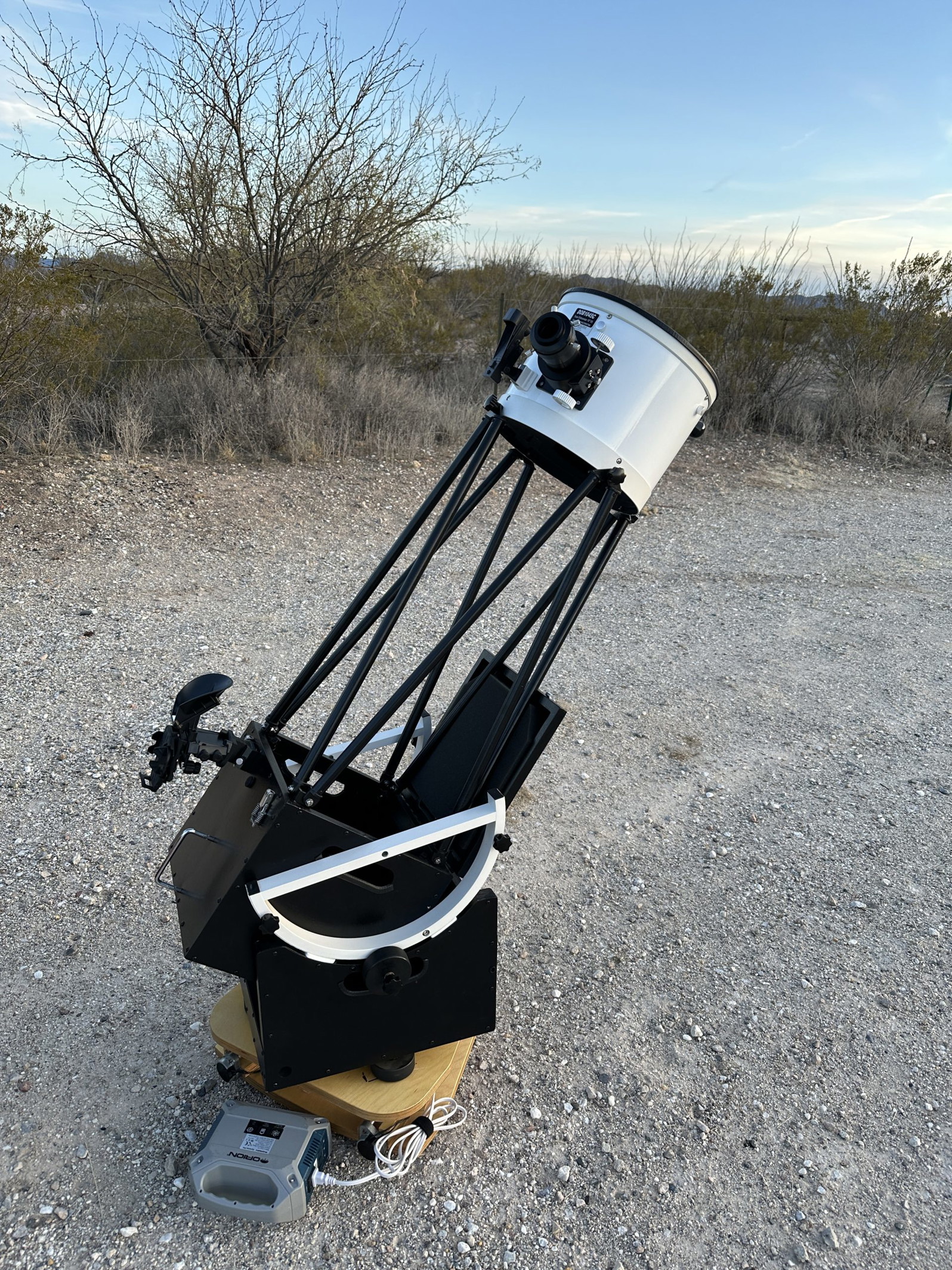
These truss designs allow the optical tube, which can be the bulkiest part of the telescope, to be collapsed or disassembled into more compact segments. This modularity further enhances the Dobsonian’s portability and ease of storage. When not in use or during transport, these segments can be neatly packed away, saving a significant amount of space.
The truss tube designs usually result in a fairly compact “rocker box” or base. Also, many commercial truss tube telescopes have a base that can be packed flat without the use of tools to reduce volume further. When transported, the cuboid nature of the sub-assemblies of the telescope maximizes packing efficiency and means that you usually don’t need any kind of case or padding besides for the stowed truss poles.
While it might seem counterintuitive, even larger Dobsonians, with apertures up to 40″, have been designed with portability in mind.
Due to the Dobsonian telescope’s inherent simplicity and the modular nature of truss designs, these larger telescopes can be broken down into manageable components. From my own experience, a single individual can transport these pieces with a suitable vehicle and roll the heavy mirror/rocker box on wheels down a ramp in and out of the car or trailer. Once at the observation site, assembly is straightforward. The telescope can be set up with relative ease by just a single person in no more than 15 minutes.
Ease of Construction
Dobsonians are the easiest telescope to build, whether it’s yourself at home or on an assembly line. Part of this is because they are Newtonian reflecting telescopes.
- Only the primary mirror is a complex optic. A reflector’s parabolic primary mirror is far easier to grind and polish than a complex refractor lens or multiple curved mirrors such as seen in Maksutovs and Schmit Cassegrains.
- The secondary mirror in the reflector design is a flat mirror that’s easy to mass-produce.
- The mount of a Dobsonian can be made entirely out of plywood, apart from the plastic bearing surfaces.
Even if you’ve bought your own Dobsonian, the ease of fabricating parts for one is still an important aspect of these telescopes.
- You can make a new base for your telescope if your old one is damaged or you find it too heavy.
- You can fabricate your own bearings or replace the laminate/pads on your telescope if you don’t like how it moves.
- You can also easily add hardware to the sides of the base, such as wheels, eyepiece racks, a tablet stalk, etc., just by drilling holes and tapping in wood screws.
Longevity
Arguably the most critical component of a Dobsonian or Newtonian telescope, the primary mirror, is impressively durable. With proper care and maintenance, protected aluminum mirror coatings can last anywhere between 50 and 100 years. Cheaply-done “enhanced aluminum” still lasts around 20 years or so. The quartz overcoat on mirror coatings staves off physical abrasion and chemical corrosion, while the aluminum itself takes decades to oxidize and eventually corrode off the glass.
Moreover, if the need arises, recoating the primary mirror is a fairly affordable endeavor. For enthusiasts keen on DIY solutions, silver recoats can be done at home, although silver does have a propensity to tarnish and will need attention roughly on an annual basis.
Interestingly, the secondary mirror of most telescopes, due to its upside-down orientation during proper storage, generally lasts even longer without the need for recoating.
Unlike Schmidt telescopes, which have a thin corrector that can shatter, or other designs that possess a vulnerable, thick, and expensive lens at the front, the primary mirror of a Newtonian reflector sits at the bottom of the tube. The secondary is not nearly as at risk if the telescope is dropped, etc., and can be replaced for a fairly low cost if it is somehow damaged.
Dobsonian telescopes shun complexity in favor of user-friendly mechanics. They avoid complex mechanical parts that might be challenging or expensive to replace. Most of the telescope’s components can be repaired or replaced using common hardware, making maintenance accessible and cost-effective. The Dobsonian mount, renowned for its simplicity, can be reconstructed from scratch without much hassle.
Finally, Dobsonians are also designed to be tough:
- Minor dents to the tube, for instance, typically don’t affect performance.
- Similarly, the particle board mounts of mass-manufactured scopes can swell, warp, and otherwise deviate slightly from their original shape without losing functionality.
- Even if the coatings or mirrors sustain minor damage, the performance drop at the eyepiece through a telescope is usually negligible, and recoating is a straightforward process, as mentioned above.
- In fact, even computerized Dobsonians, if faced with electronic failures, can typically still be operated manually to no detriment.

What do you guys think about the Celestron NexStar 130 SLT?
Hi there. The tripod is not very stable and the hand controller is straight out of the 1990s. The newer Celestron Astro-Fi 130 is a better choice if you must have a GoTo.